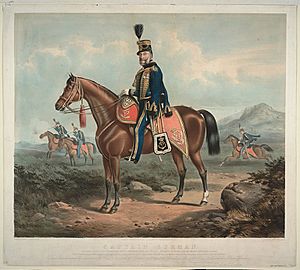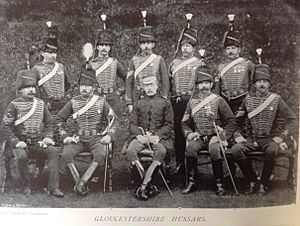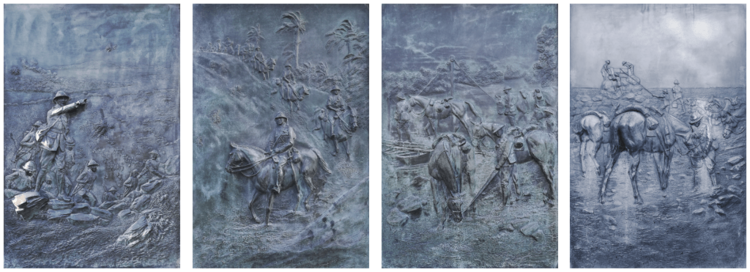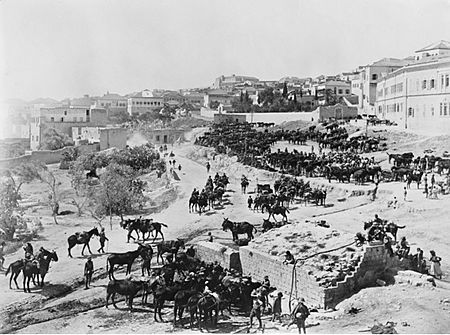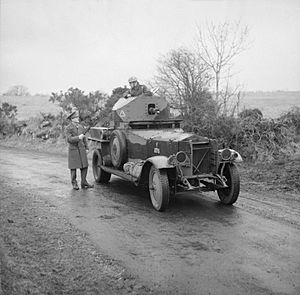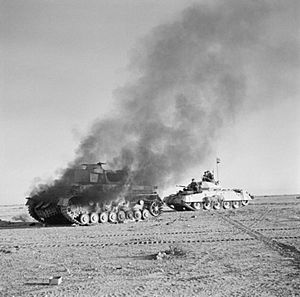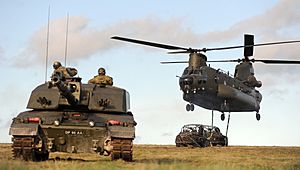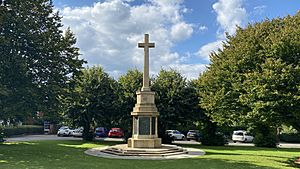Royal Gloucestershire Hussars facts for kids
Quick facts for kids Royal Gloucestershire Hussars |
|
|---|---|
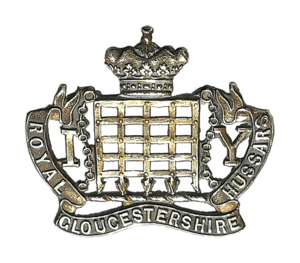
Royal Gloucestershire Hussars cap badge from the period of the Imperial Yeomanry
|
|
| Active | 1830–present |
| Country | |
| Branch | |
| Type | Royal Armoured Corps |
| Role | Armour Replacement |
| Part of | Royal Wessex Yeomanry |
| March | Quick: D'ye ken John Peel? |
| Engagements | Second Boer War First World War |
| Commanders | |
| Honorary Colonel | Colonel John F. Penley, OBE |
| Notable commanders |
Henry Somerset, 7th Duke of Beaufort Henry Somerset, 8th Duke of Beaufort |
The Royal Gloucestershire Hussars was a special group of volunteer soldiers. They were part of the volunteer yeomanry, which means they were originally cavalry (soldiers on horseback). In the 20th century, they became part of the British Army Reserve, a group of part-time soldiers.
The regiment started a long time ago, with the first group forming in 1795. However, their official history dates back to a troop raised in 1830. These early groups were made up of nobility (rich families) and gentry (landowners), and their soldiers were mostly landholders and tenant farmers. In 1834, several of these groups in Gloucestershire joined together to form the Gloucestershire Yeomanry Cavalry. By 1847, they started wearing a special hussar uniform and changed their name to the Royal Gloucestershire Hussars.
At first, the yeomanry helped keep order in the country and prepared for a possible French invasion that never happened. They also acted like mounted police during times of trouble. For example, they were sent to Bristol in the 1830s to help the police. Later, as regular police forces grew, the yeomanry focused more on defending the country.
The Royal Gloucestershire Hussars earned their first battle honour (a special award for fighting bravely) in South Africa during the Second Boer War. Before the First World War, all volunteer forces, including the yeomanry, became part of the Territorial Force. During the First World War, the regiment fought as infantry (foot soldiers) at Gallipoli and as cavalry (horseback soldiers) in the Sinai and Palestine Campaign. After the war, the regiment became smaller and changed into the 21st (Royal Gloucestershire Hussars) Armoured Car Company, using armoured cars instead of horses.
When the Second World War started, the Royal Gloucestershire Hussars became an armoured regiment again. The 2nd Royal Gloucestershire Hussars fought bravely in North Africa, often with the famous 7th Armoured Division, known as the Desert Rats. They faced many challenges and suffered heavy losses, eventually being disbanded in 1943. After the war, the regiment became smaller again, focusing on reconnaissance (scouting) with armoured cars. Today, the Royal Gloucestershire Hussars are part of the Royal Wessex Yeomanry, helping to train crews for modern Challenger 2 tanks.
Contents
How the Regiment Began
In 1794, the British Prime Minister, William Pitt, worried about unrest at home and a possible invasion from France. He asked for more cavalry (soldiers on horseback) to help defend the country. The government then asked each county's Lord Lieutenant (the King's representative) to create volunteer cavalry groups. These groups were called "yeomanry" and were made up of gentlemen and farmers.
Each group had 50 to 80 men. The person who started the group became its commander. Officers were usually from noble or wealthy families, and the soldiers were often landowners or farmers. They had to provide their own horses and were not paid unless they were called to duty. The government provided weapons, and the commanders provided uniforms. The yeomanry could only be called out by the Lord-Lieutenant or the King to stop civil unrest or to fight off a foreign invasion.
The first yeomanry group in Gloucestershire was the Cheltenham Troop, formed in 1795. By 1798, there were eight such groups. After a short period of peace, Napoleon's planned invasion of the United Kingdom made the government bring back old groups and form new ones. By 1813, Gloucestershire had 582 yeomanry soldiers. They helped with ceremonies and kept the peace. For example, the Gloucester Troop escorted the Prince of Wales in 1807. After Napoleon's defeat, most yeomanry groups were disbanded, but the Gloucester Troop stayed on as mounted police until 1827.
Forming the Royal Gloucestershire Hussars
New yeomanry groups were formed in the 1830s because of riots. The first new group in Gloucestershire was the Marshfield and Dodington Troop, started in 1830. This is the year the Royal Gloucestershire Hussars officially trace their beginning. This troop had officers, non-commissioned officers, a trumpeter, and fifty soldiers. They were recruited from the estates of local landowners, including the Duke of Beaufort.
In 1831, six more groups were formed in Gloucestershire. That same year, the Dodington and Tetbury Troops were sent to Bristol to help with civil unrest after a new law was defeated in Parliament.
In 1834, all the yeomanry captains in Gloucestershire met and decided to combine their groups into one regiment. They called it the Gloucestershire Yeomanry Cavalry. Its first commander was the Marquis of Worcester, who later became the 7th Duke of Beaufort. This started a long connection between the regiment and the Beaufort family. The new regiment had seven groups and a total of 26 officers and 382 soldiers. They wore light dragoon uniforms and carried swords and pistols.
In 1838, the Dodington and Winterbourne Troops helped police a Chartist rally in Bristol. In 1841, the regiment was given the special title 'Royal'. In 1847, they changed to a blue hussar uniform and became the Royal Gloucestershire Hussars. The Duke of Beaufort was very influential; he even ordered all members to grow moustaches!
The regiment had strong ties to farming communities. For example, annual training was sometimes delayed due to early or late harvests. In the late 1870s and early 1880s, fewer men attended training because of bad harvests. By 1890, many members were fox hunters, and the regiment adopted an old hunting song, D'ye ken John Peel, as its march.
As civilian police forces grew, the yeomanry focused more on national defence. In 1871, they got new breech-loading carbines (a type of rifle). By 1875, they were practicing scouting and defence exercises in the hills. In 1893, the army officially organized the groups into squadrons:
- A Squadron – Gloucester and Berkeley Troops
- B Squadron – Cheltenham and Tewkesbury Troops
- C Squadron – Monmouth and Chepstow Troops
- D Squadron – Badminton and Dodington Troops
The Royal Gloucestershire Hussars joined the Royal Wiltshire Yeomanry in the 3rd Yeomanry Brigade and trained together for the first time in 1895.
In 1899, the British government created the Imperial Yeomanry to help the regular army during the Second Boer War in South Africa. The Royal Gloucestershire Hussars sent 125 volunteers. They became part of the Imperial Yeomanry as mounted riflemen. They arrived in South Africa in 1900 and fought their first battle on May 5. They served for 18 months and were involved in 65 fights, though more men died from sickness than from enemy action. When they returned in 1901, the Royal Gloucestershire Hussars earned their first battle honour: "South Africa 1900–01".
In 1901, the yeomanry was renamed the Imperial Yeomanry. They were given new Lee–Enfield rifles and bayonets and a standard khaki uniform. This made some worry they were becoming infantry instead of cavalry. But by 1913, swords were brought back for general use. In 1908, all volunteer forces, including the yeomanry, became part of the Territorial Force. The Royal Gloucestershire Hussars had their first training under this new system in 1909.
The First World War
When the First World War began on August 4, 1914, the regiment quickly got ready for war. They joined other units in Warwick. As a territorial regiment, they didn't have to serve overseas, but they volunteered to do so. Because of this, a second regiment was formed in September 1914 to stay in the UK for home defence. A third regiment was raised in 1915 to provide new soldiers. These were called the 1/1st, 2/1st, and 3/1st Royal Gloucestershire Hussars.
The second regiment stayed in England for most of the war. In July 1916, they swapped their horses for bicycles and became a cyclist unit. The third regiment served as a reserve, training new soldiers.
Fighting at Gallipoli
In April 1915, the 1/1st Royal Gloucestershire Hussars sailed to Egypt. On August 14, they went to Gallipoli without their horses, arriving three days later. They fought as infantry (foot soldiers) at Chocolate Hill on August 21, supporting another division. During this battle, 61 soldiers were injured or killed. They stayed in the area until the end of October, serving in trenches. Many men became sick or were hit by enemy shells. When they left Gallipoli on October 31, only about 100 of the original 361 men were still fit to fight.
Battles in Egypt
After a short break, the regiment returned to Egypt in November 1915. They got their horses back and were brought back to full strength. In January 1916, they were stationed near the Suez Canal. By late March, they were patrolling the Sinai desert.
On April 23, A Squadron was attacked by a Turkish force. They fought bravely but were eventually overwhelmed. The battle cost the Royal Gloucestershire Hussars 98 soldiers, most of whom were captured. Only nine men from A Squadron escaped. Some people criticized the squadron for going too far, but Lieutenant-General Sir Philip Chetwode later defended them, saying they had nothing to be ashamed of.
While A Squadron was rebuilt, B and D Squadrons formed a combined unit. On August 4, D Squadron played a key role in the Battle of Romani. They held a dangerous gap in the lines for three hours, and their commander, Major Charles Turner, received a special award for his bravery. Later, the regiment helped capture 500 prisoners, four guns, and two machine guns. British forces continued to advance across the Sinai. The regiment fought again on January 9, 1917, in the Battle of Rafa, suffering 46 casualties.
Campaigns in Palestine
After the Battle of Rafa, the regiment joined the Imperial Mounted Division. On March 26, they helped attack Gaza from the south in the First Battle of Gaza. This attempt failed, as did the Second Battle of Gaza in April.
In June, General Edmund Allenby took command of the British forces. In October, he started a new attack in southern Palestine. The regiment fought on November 4 in the Battle of Tel el Khuweilfe, suffering 14 casualties. They also fought a defensive battle on November 12, just before the Battle of Mughar Ridge, losing 21 men. In December, they helped stop a Turkish attack near Jaffa.
In early 1918, the regiment was in reserve, enjoying fox hunts and leave in Jaffa and Jerusalem. In May, they fought in the Second Action of Es Salt. This battle ended in defeat, and they retreated. They stayed in the hot Jordan valley until August, suffering more from sickness like malaria than from enemy attacks.
In August, the regiment moved to the coast to prepare for the next attack. On September 19, they led the advance after the infantry broke through enemy lines. They rode over 50 miles (80 km) and entered Nazareth with swords drawn the next day. They captured the town on September 21. By the end of September, the regiment reached Damascus. On October 27, just before the war ended, they entered Aleppo. During this march, they even found the sword of Captain Lloyd-Baker, which had been taken by the Turks after he died at Qatia two years earlier.
Between the World Wars
After the war, the regiment stayed in Palestine and slowly sent its soldiers home. The last group arrived in Gloucester on August 15, 1919. The names of the 28 officers and 200 soldiers who died in the war are on the Royal Gloucestershire Hussars war memorial at Gloucester Cathedral.
The Territorial Force was reformed in 1920 and renamed the Territorial Army (TA). The Royal Gloucestershire Hussars began recruiting new members. In 1921, the army decided that only the oldest yeomanry regiments would remain as cavalry. The others could become artillery units or smaller armoured car companies. On November 25, the regiment chose to become the 21st (Royal Gloucestershire Hussars) Armoured Car Company (TA). They were equipped with Peerless armoured cars, which were later replaced by Rolls-Royce Armoured Cars.
As war approached again in Europe, the UK expanded its armed forces. The armoured car company became a full armoured regiment again on April 30, 1939, and got its original name back: the Royal Gloucestershire Hussars. The TA doubled in size, with each regiment creating a duplicate. So, the 1st Royal Gloucestershire Hussars and the 2nd Royal Gloucestershire Hussars were both recruiting new members.
The Second World War
When the Second World War began, the 1st Royal Gloucestershire Hussars used light tanks and helped defend the UK. Later, they were equipped with Valentine tanks and were supposed to go to North Africa. However, they stayed in the UK as a training regiment, teaching over 5,000 officers and men. After the war, they were sent to Austria as part of the army of occupation. The 3rd Royal Gloucestershire Hussars was a small group that acted as a training unit, a testing unit, and even a decoy, building dummy tanks to trick the enemy about British tank strength.
The 2nd Royal Gloucestershire Hussars went to Egypt in October 1941. By mid-November, they were near the Libyan border, part of the 22nd Armoured Brigade, which was attached to the famous 7th Armoured Division, the Desert Rats. The regiment had 43 officers, 585 soldiers, 52 Crusader tanks, and many other vehicles.
Operation Crusader
In Operation Crusader, the 7th Armoured Division's job was to find and destroy enemy tanks. The 2nd Royal Gloucestershire Hussars led the advance. On November 19, they met the Italian Ariete Division. The regiment lost 30 tanks and about 50 soldiers. Their commanding officer, Lieutenant-Colonel Charles Birley, was wounded but continued to direct the regiment, earning a special award.
The regiment, now with only 19 tanks, fought again on November 22 and 23 at Sidi Rezegh. They were heavily damaged by German tanks. In a short break, they were given more tanks, including M3 Stuarts (called Honey tanks by the British). They fought again on November 27 and 28, still facing stronger enemy tanks. After this battle, they were given 52 Honey tanks. So far, the fighting had cost the regiment 16 officers and 70 soldiers.
In December, the regiment continued to fight as British forces pushed the enemy out of Cyrenaica. Operation Crusader ended, and the regiment had suffered 169 casualties.
Battle of Gazala
Birley returned to command the regiment in January 1942. The regiment was re-equipped with new M3 Grant tanks and Crusaders. In May, they had 36 officers, 563 soldiers, and 48 tanks. At the end of May, they fought in the Battle of Gazala. They quickly lost many tanks. On June 1, they handed over their remaining Crusaders and were pulled out of the line for new equipment.
The regiment returned to the fight on June 4 with more Honey and Grant tanks. The next day, they took part in a failed attack. On June 6, their command tank was hit, killing Birley and another officer. The regiment was down to only 17 Honey tanks and two Grants. For the next two days, Major W. A. B. Trevor took command. On June 10, one squadron helped fight around Bir Hacheim. The Battle of Gazala cost the regiment 82 casualties. On June 12, Trevor was also killed in an airstrike. The remaining officers tried to keep the regiment from being split up.
Being Split Up and Disbanded
After the defeat at Gazala, British forces stopped the enemy advance in the First Battle of El Alamein. While one squadron fought there, the other two became infantry (foot soldiers) and guarded areas in the Delta. In August, one squadron was given Crusaders and became part of the Army reserve.
During the Battle of Alam el Halfa, the regiment's squadrons fought as parts of other units. The three squadrons were reunited on September 20, but any hope of fighting together again was lost. The squadrons were transferred to other regiments, and the 2nd Royal Gloucestershire Hussars was disbanded on January 15, 1943. During its short time, the regiment lost 72 men killed, 100 wounded, and 85 taken prisoner. They earned many awards for their bravery.
After the War
The regiment was reformed in 1947 for reconnaissance (scouting) duties. They used Daimler Armoured Cars, later replaced by Ferret scout vehicles. In 1962, a new flag (called a Guidon) was presented to them by the Queen. In 1963, they were given the Freedom of Gloucester, a special honour.
In 1967, the regiment became smaller, becoming a squadron combined with parts of other units to form the Wessex Volunteers. In 1969, it was reduced even further to just eight men, but two years later, it grew again to form the headquarters and two squadrons of the Wessex Yeomanry, which became the Royal Wessex Yeomanry in 1979.
In 1983, the new yeomanry regiment used Land Rovers for scouting. In the 1990s, they became an armoured reserve regiment. Their job was to train new crews for the regular army's Challenger 2 tanks. Today, the history of the Gloucestershire yeomanry is continued by C (Royal Gloucestershire Hussars) Squadron in the Royal Wessex Yeomanry.
Battle Honours
These are the special awards the regiment earned for fighting bravely in battles:
| Boer War | South Africa 1900–01 |
|---|---|
| First World War | Suvla, Scimitar Hill, Gallipoli 1915, Rumani, Rafah, Egypt 1915–17, Gaza, El Mughar, Nebi Samwil, Jerusalem, Megiddo, Sharon, Damascus, Palestine 1917–18 |
| Second World War | Tobruk 1941, Gubi I, Sidi Rezegh 1941, Chor es Sufan, Gazala, Bir el Aslagh, Cauldron, Alam el Halfa, West Point 23, North Africa 1941–42 |
Honorary Regimental Colonels
These are some of the special honorary colonels of the regiment:
- Royal Gloucestershire Hussars
- 1904– Col. Henry Somerset, 9th Duke of Beaufort, TD, DL, JP, ADC
- 1926– Col. Henry Somerset, 10th Duke of Beaufort, KG, GCVO, PC
- 1967– Col. Henry Somerset, 10th Duke of Beaufort, KG, GCVO, PC [reappointed]
- 1969– Col. Henry Somerset, 10th Duke of Beaufort, KG, GCVO, PC [reappointed]
- C (Royal Gloucestershire Hussars) Squadron, Royal Wessex Yeomanry (1971)
- 1972– Col. Henry Somerset, 10th Duke of Beaufort, KG, GCVO, PC [reappointed]
- 1984– Lt. (Hon. Col.) David Somerset, 11th Duke of Beaufort
- 1994– Col. John Evelyn Baring Hills, TD, DL
- 1999– Lt-Col. David R. Ayshford-Sanford, TD
See also


